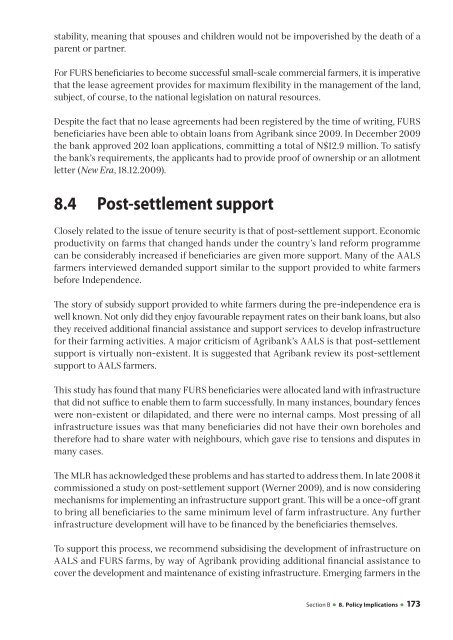Namibia country report
Namibia country report
Namibia country report
- No tags were found...
You also want an ePaper? Increase the reach of your titles
YUMPU automatically turns print PDFs into web optimized ePapers that Google loves.
stability, meaning that spouses and children would not be impoverished by the death of aparent or partner.For FURS beneficiaries to become successful small-scale commercial farmers, it is imperativethat the lease agreement provides for maximum flexibility in the management of the land,subject, of course, to the national legislation on natural resources.Despite the fact that no lease agreements had been registered by the time of writing, FURSbeneficiaries have been able to obtain loans from Agribank since 2009. In December 2009the bank approved 202 loan applications, committing a total of N$12.9 million. To satisfythe bank’s requirements, the applicants had to provide proof of ownership or an allotmentletter (New Era, 18.12.2009).8.4 Post-settlement supportClosely related to the issue of tenure security is that of post-settlement support. Economicproductivity on farms that changed hands under the <strong>country</strong>’s land reform programmecan be considerably increased if beneficiaries are given more support. Many of the AALSfarmers interviewed demanded support similar to the support provided to white farmersbefore Independence.The story of subsidy support provided to white farmers during the pre-independence era iswell known. Not only did they enjoy favourable repayment rates on their bank loans, but alsothey received additional financial assistance and support services to develop infrastructurefor their farming activities. A major criticism of Agribank’s AALS is that post-settlementsupport is virtually non-existent. It is suggested that Agribank review its post-settlementsupport to AALS farmers.This study has found that many FURS beneficiaries were allocated land with infrastructurethat did not suffice to enable them to farm successfully. In many instances, boundary fenceswere non-existent or dilapidated, and there were no internal camps. Most pressing of allinfrastructure issues was that many beneficiaries did not have their own boreholes andtherefore had to share water with neighbours, which gave rise to tensions and disputes inmany cases.The MLR has acknowledged these problems and has started to address them. In late 2008 itcommissioned a study on post-settlement support (Werner 2009), and is now consideringmechanisms for implementing an infrastructure support grant. This will be a once-off grantto bring all beneficiaries to the same minimum level of farm infrastructure. Any furtherinfrastructure development will have to be financed by the beneficiaries themselves.To support this process, we recommend subsidising the development of infrastructure onAALS and FURS farms, by way of Agribank providing additional financial assistance tocover the development and maintenance of existing infrastructure. Emerging farmers in theLivelihoods after Land Reform: Section <strong>Namibia</strong> B ● 8. <strong>country</strong> Policy Implications <strong>report</strong> (2010) ● 173
















